Asus ROG Swift PG258Q Monitor Review
Why you can trust Tom's Hardware
Color Gamut & Luminance
For details on our color gamut testing and volume calculations, please click here.
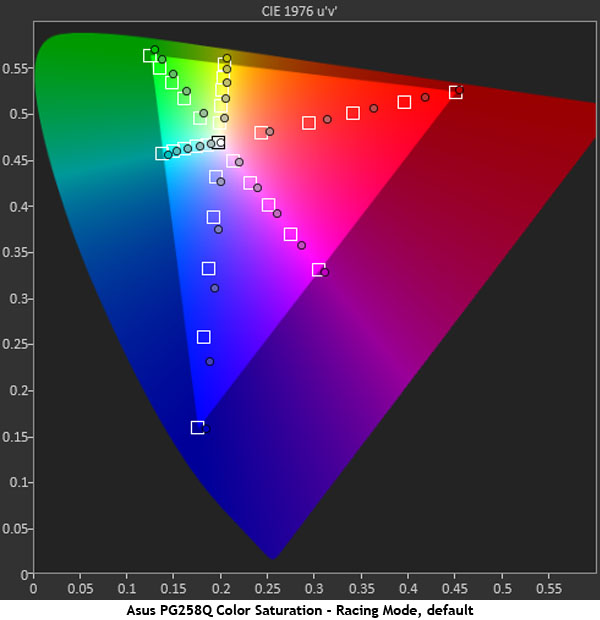
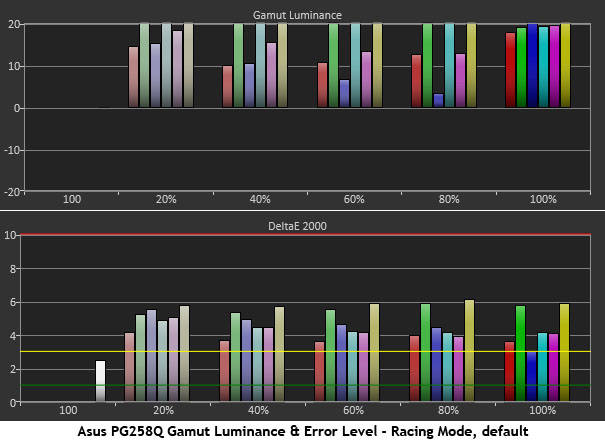
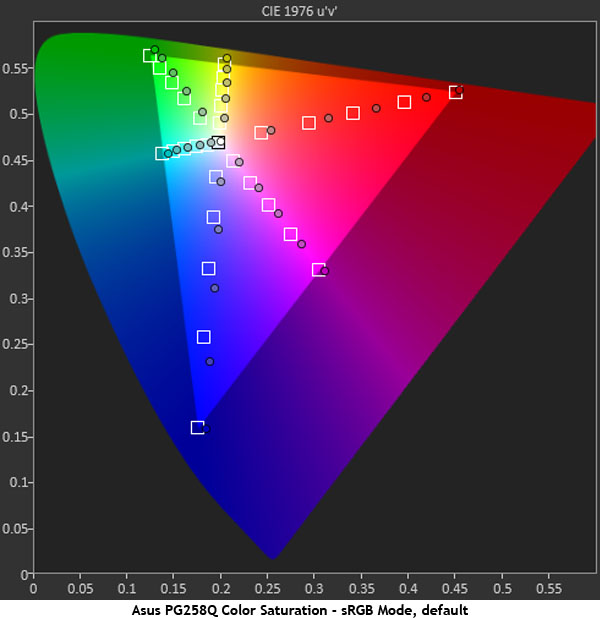
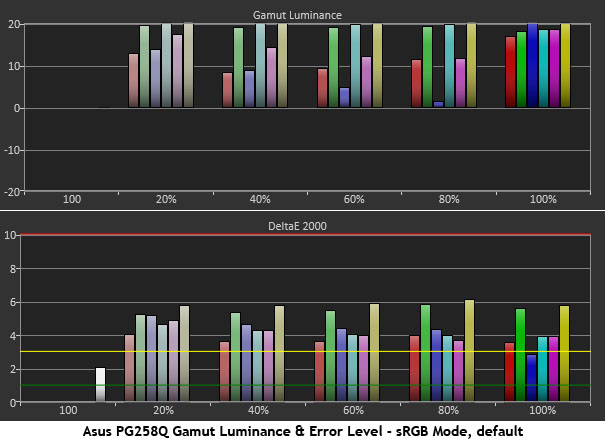
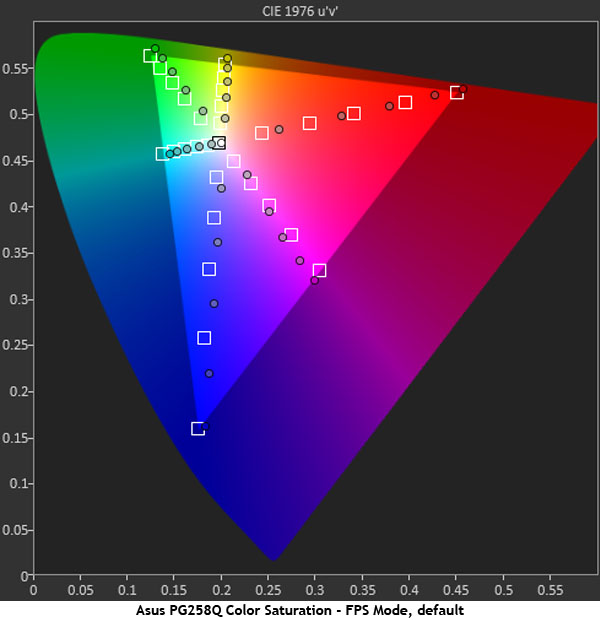
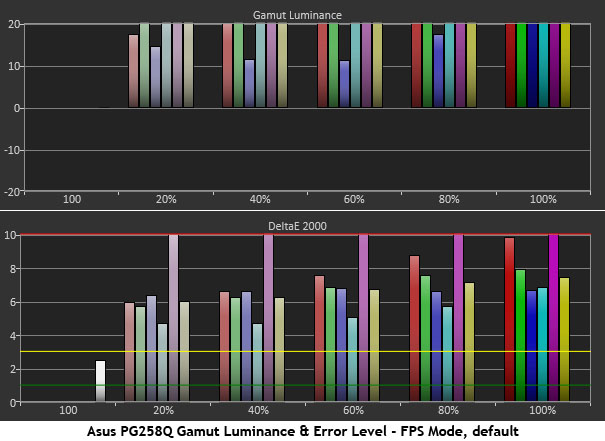
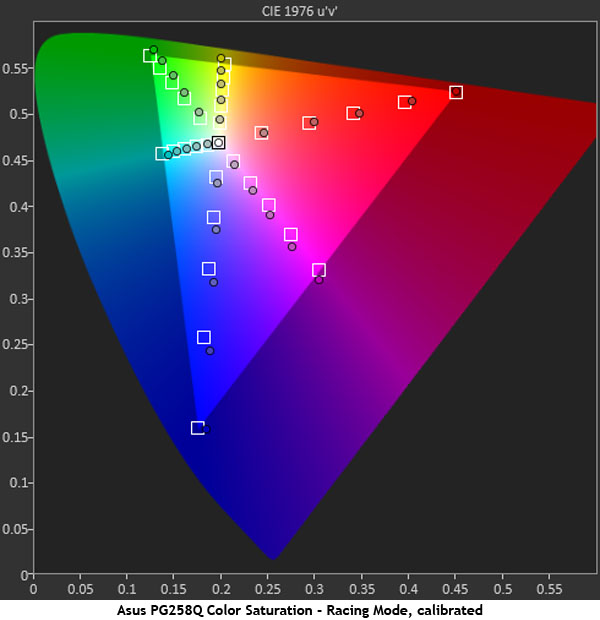
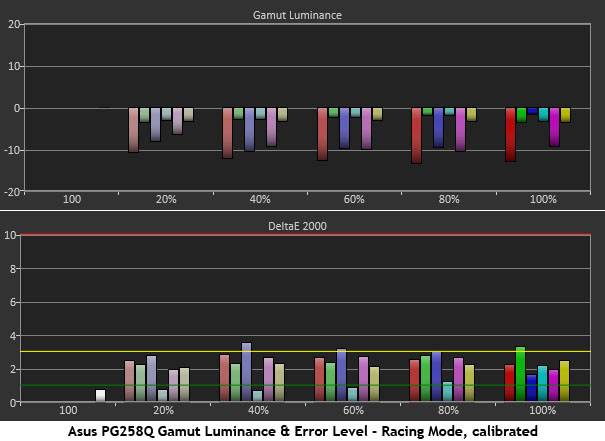
In the first three tests (Racing, sRGB, and FPS), you can see that the outer color points (100% saturation) are right on target, but the inner measurements, those that represent the lion’s share of image content, are quite over-saturated. FPS is the worst with targets that are off by nearly 20% in some cases. The extra luminance only serves to clip detail. The sole reason for this is gamma tracking and how it is thrown off by that too-high Contrast setting. It is fortunate that the fix is an easy one. And if you refer back to page three, you’ll see that lowering the slider to 41 doesn’t cost you any dynamic range.
Our tweaks have brought almost all measured points to their targets, and luminance is only slightly under the neutral level for red, blue, and magenta. Nearly every DeltaE value is under three and the image has far more detail than before. What’s the takeaway? Asus should consider setting its default Contrast value differently. It’s the PG258Q’s key to accuracy.
Comparisons
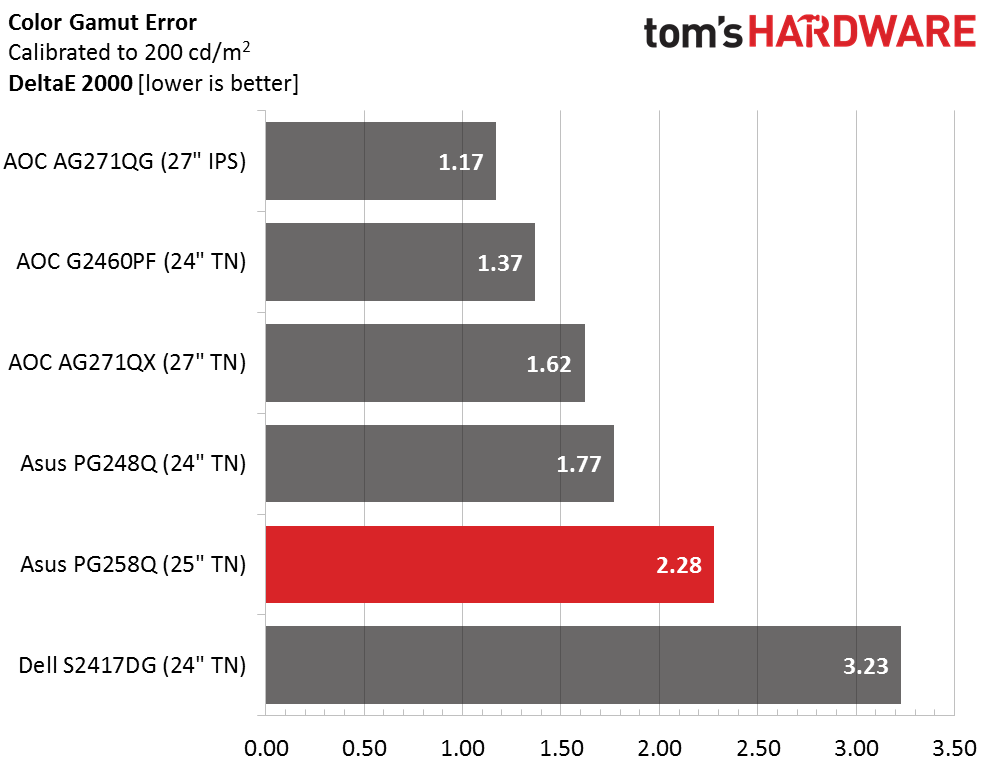
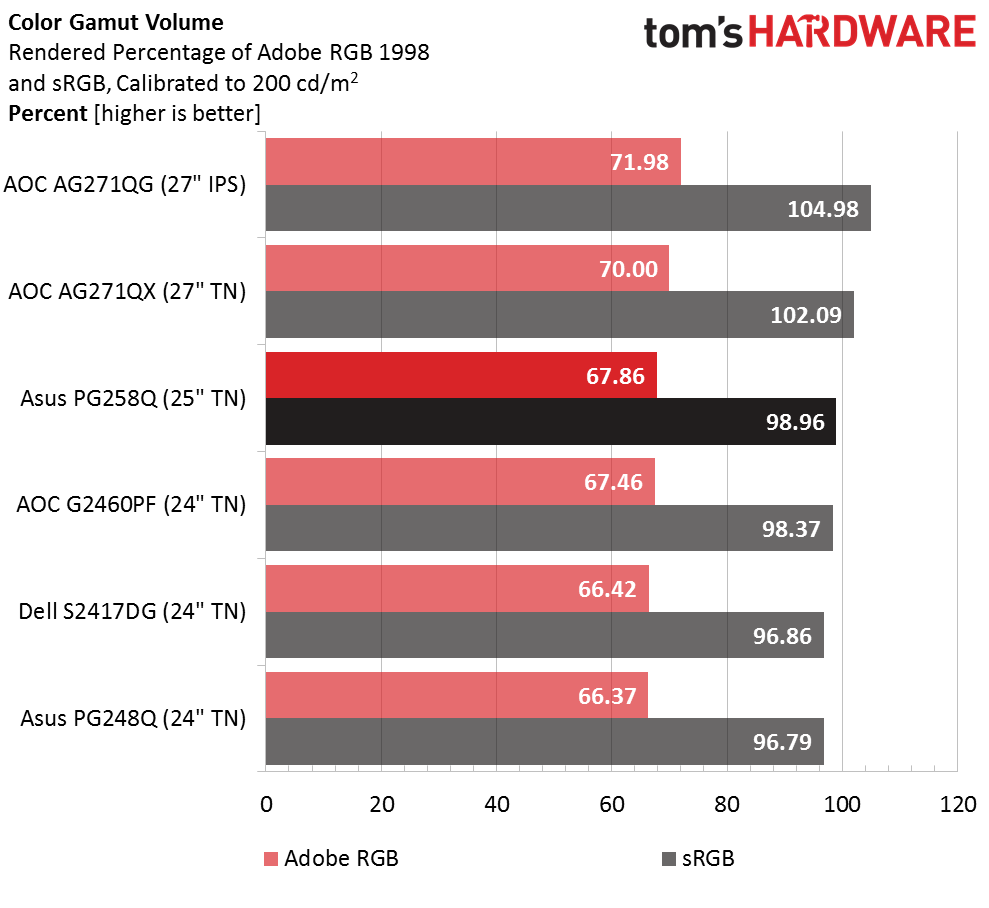
2.28dE is only a fair result but since the PG258Q started at 4.70dE, we’re satisfied. We still have great contrast and depth, and maximum color detail is now realized. The change in visual perception is significant and can easily be seen in a side-by-side comparison. It’s not to say the monitor looks bad out of the box. It’s just that we found a fair bit of performance left unrealized.
Our gamut volume test shows just under 100% coverage for sRGB. A custom profile is nearly always recommended, but for most graphics and photo work, the PG258Q will fill the role nicely. When properly set up, this monitor is suitable for pretty much any task from gaming to productivity.
MORE: Best Computer Monitors
MORE: How To Choose A Monitor
Get Tom's Hardware's best news and in-depth reviews, straight to your inbox.
MORE: All Monitor Content
Current page: Color Gamut & Luminance
Prev Page Gamma Response Next Page Viewing Angles, Uniformity, Response & Lag
Christian Eberle is a Contributing Editor for Tom's Hardware US. He's a veteran reviewer of A/V equipment, specializing in monitors. Christian began his obsession with tech when he built his first PC in 1991, a 286 running DOS 3.0 at a blazing 12MHz. In 2006, he undertook training from the Imaging Science Foundation in video calibration and testing and thus started a passion for precise imaging that persists to this day. He is also a professional musician with a degree from the New England Conservatory as a classical bassoonist which he used to good effect as a performer with the West Point Army Band from 1987 to 2013. He enjoys watching movies and listening to high-end audio in his custom-built home theater and can be seen riding trails near his home on a race-ready ICE VTX recumbent trike. Christian enjoys the endless summer in Florida where he lives with his wife and Chihuahua and plays with orchestras around the state.
-
apertotes I just don't get it. How can you leave the contrast (arguably the most importante feature on a screen after the resolution) out of the first page of the article? I couldn't care less about the bezel width, but please, state the contrast!Reply -
ahnilated 1080P, *sigh* who wants this anymore! Get me a 4K monitor at 30-32" with good specs and G-Sync that isn't $4000.Reply -
dstarr3 Reply19637653 said:1080P, *sigh* who wants this anymore! Get me a 4K monitor at 30-32" with good specs and G-Sync that isn't $4000.
Because that's the reality of GPUs at the moment. GPUs can get you a solid 4K/60 or a solid 1080p/144. You're not going to get 4K/144 in any modern games on any PC at the moment (unless you're only playing 20-year-old games). So there's not a lot of sense in wanting to invest in a 4K/144 monitor now, only in anticipation of when GPUs can finally push that many pixels, because you'll be wasting the monitor while you wait, and when such GPUs finally do arrive, the monitors will be better and cheaper. -
Rosanjin Do we know if this monitor is 3dVision capable?Reply
I would assume so, but I've learned some very expensive lessons by making purchases based on assumptions. : / -
ahnilated Reply19637717 said:19637653 said:1080P, *sigh* who wants this anymore! Get me a 4K monitor at 30-32" with good specs and G-Sync that isn't $4000.
Because that's the reality of GPUs at the moment. GPUs can get you a solid 4K/60 or a solid 1080p/144. You're not going to get 4K/144 in any modern games on any PC at the moment (unless you're only playing 20-year-old games). So there's not a lot of sense in wanting to invest in a 4K/144 monitor now, only in anticipation of when GPUs can finally push that many pixels, because you'll be wasting the monitor while you wait, and when such GPUs finally do arrive, the monitors will be better and cheaper.
The reason you won't get it is because the GPU's won't do it, not because the games won't. Game developers want to make more realistic games but the GPU's are lagging way behind. Nvidia hasn't had any real competition for many years so there was no need for them to push to 4K gaming at 144Hz or higher. I am hoping AMD's cards will force Nvidia to get off their buts as it seems the consumers aren't going to pull their money from Nvidia until Nvidia gets back on the ball. -
Geo Matrix I agree with AHNILATED! DSTARR3 says, "Because that's the reality of GPUs at the moment". I say let's have some serious change! Asus and Nvidia are "milking the cow" with these old relics. Everything is now going 4K, 6K and 8K. It's time to stop milking the cow and people's wallets and put out the new technology. It's 2017, not 1980. We all know the new tech is already here.Reply -
dstarr3 Based on the performance bump we saw from the 1080 Ti, I don't think it's fair to say that nVidia's slouching when it comes to GPU performance. Pricing, sure, they could use more competition. But something like 4K/144 is a seriously enormous amount of processing to do. The DisplayPort and HDMI interfaces themselves had to be updated to transfer that much data. I'm amazed we got 4K/60 out of GPUs as quickly as we did. Give it another generation and we should be hovering around 4K/144. But you ask why there's no 4K/144 gaming monitors coming out yet, and this is why. There aren't any 4K/144 GPUs out yet, either. And it's not because any particular company is stagnating. It's because pushing that many pixels to a monitor is a huge, huge task.Reply -
Deadshot-89 I use an Eizo EV 2336W. It has incredibly accurate and incredibly deep and vidid colors right out of the box. It also has a very deep picture and for an IPS screen very deep blacks. And to top it all off, it has extremely nice viewing angles, no color-shifts and it retains a ton of brightness at very steep angles. Motion performance is very OK for a 60 Hz screen.Reply
My current hardware isn't really capable of producing more than a reliable 1080p60. (GTX 970, i5-4590). So I see no reason to switch to a higher res screen or higher refresh rate screen.